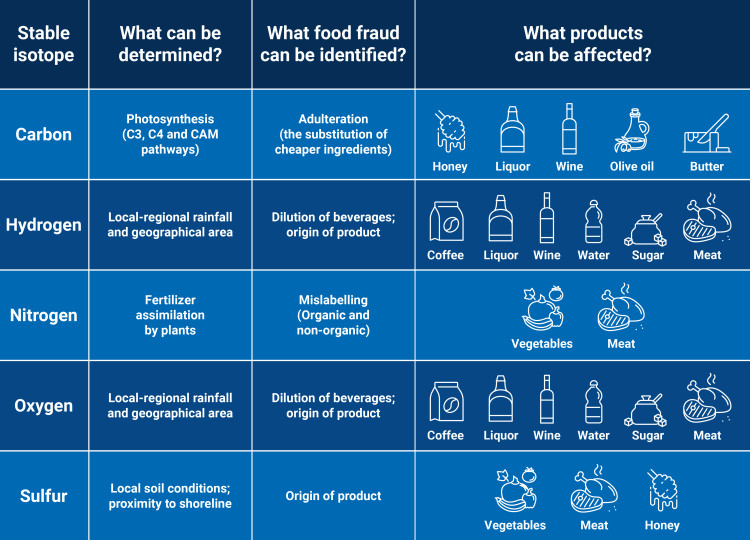Food fraud can be defined as any intentional action, taken to deceive customers about the quality and content of the food products for financial gain. The selling of fake food around the world has become a highly lucrative illegal activity. While estimating the global impact is hard because it is designed to avoid detection, some experts are assessing that it could represent 40 billion dollars a year.
It is important for consumers to be sure that the quality and safety of food they buy is guaranteed. Many people prefer goods from certain brands due to their reputation for good quality. Some may even be ready to pay premium prices for their characteristics and ingredients. This attracts fraudsters, who try to turn a profit by replacing high quality ingredients with cheaper ones and pocketing the price difference.
Mitigating the risk of food fraud can be difficult. Fraud may happen at any stage of the supply chain, and in some cases, it cannot be detected without special equipment. In developing countries, the problem is aggravated by the lack of technical capacity to detect food fraud.
Types of food fraud

There are various forms of food fraud that can occur alone or in combination. Source: based on data from European Commission (2020) (Infographic: M.Platonova/IAEA).
- Dilution - a high value liquid ingredient is mixed with a lower value liquid to reduce the concentration and lower the costs of production.
- Mislabeling - false information is placed on the packaging or the label.
- Unapproved enhancement - unknown/undeclared materials are added to a food product.
- Substitution - a high value ingredient or part of a product is replaced with another ingredient/part of lower value.
- Concealment - poor quality food ingredients or products that are intentionally hidden.
- Counterfeiting - a brand name, design, recipe, or unique techniques are copied.
- Grey market production/theft/diversion - unregistered products are sold.
The harm from food fraud
Harm to human health. Food fraud can harm the consumer's health, as toxic additives may be added, or essential nutrients may be removed as part of the fraud process. This increases the risk of foodborne illnesses or could cause an allergic reaction due to food intolerances relating to specific ingredients that may be secretly included in fraudulent food products.

Example: the fraudster adds the liquid to honey for a more "natural" color and this causes poisoning of the consumer who thinks they are buying authentic high-quality honey. (Infographic: M.Platonova/IAEA).
Economic harm. When a product is falsified, its overall quality is diminished. Customers do not receive what they expect for the money they pay. It also impacts the legitimate companies who are losing consumers to food fraud sales. It happens with expensive product such as truffles or daily use products such as honey.

Harm to international trade. The globalization of trade and the growing complexity of production and supply chains increases the range of risks and vulnerabilities associated with fraud in relation to food, ingredients, and substances along the whole line of production. This happens because it is difficult to control all stages of the supply chain, especially if many activities and different countries are involved.

Example: different kinds of food fraud may happen at every stage of the food supply chain. (Infographic: M.Platonova/IAEA).
How do nuclear scientists detect food fraud?
Every element around us has its own chemical identity. This identity is based on its atomic composition, which consists of neutrons, protons, and electrons. Atoms with the same number of protons but different numbers of neutrons are called isotopes - these can help scientists to determine if a product is genuine.
Stable isotope ratios in food can vary because of different factors, such as: when, where, and under what environmental conditions the food was produced. For example, stable carbon isotope ratios of tomatoes from Northern Europe grown in a winter greenhouse will vary from the carbon isotope ratios of soil grown tomatoes, harvested in summer in South America.
Stable isotopes are measured using specialized equipment, that can detect the very small differences in the ratios of their heavy and light forms and this information can be used to detect the
origin of food. Stable isotope ratios are like nature's 'fingerprints' or signatures on food. This hidden evidence can provide information on whether the foods we are buying consist of the authentic ingredients described on the label or has been falsified. By tracing these isotopic fingerprints, scientists can also track the geographical or botanical provenance of food.
Isotopes also allow to detect the adulteration, or complete substitution, of food with cheap ingredients that have identical chemical structures, but different isotopic signatures. For example, synthetic flavors instead of natural, high fructose corn syrup in honey; or orange juice made from concentrate instead of freshly squeezed.

Different isotopes can be helpful for identifying various types of food fraud. (Information source: ThermoFisher Scientific). (Infographic: A.Vargas/IAEA).
What is the role of the IAEA?
- Jointly with the Food and Agriculture Organization of the United Nations (FAO), the IAEA supports its Member States in the use of nuclear and complementary techniques for science-based solutions to improve food safety, food authenticity, and security, as well as sustainable agricultural practices.
- The Joint FAO/IAEA Center of Nuclear Techniques in Food and Agriculture is working on nuclear technologies to improve the safety and quality of food products, tracking the origin of food products and checking their authenticity.
- The Joint FAO/IAEA Centre supports its member States in improving their laboratory and regulatory capacity to trade safe and high-quality food products and verify their authenticity using stable isotope measurements.
- The Joint FAO/IAEA Centre gathers best practices and provides guidance on the use of nuclear techniques for the verification of origin of food products, for example dairy products.
- The Joint FAO/IAEA Centre conducts various Coordinated Research Projects (CRP) on use of nuclear and complementary techniques, for instance, the identification of food fraud or products with high-value labelling claims.






